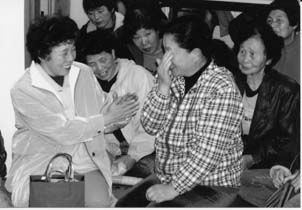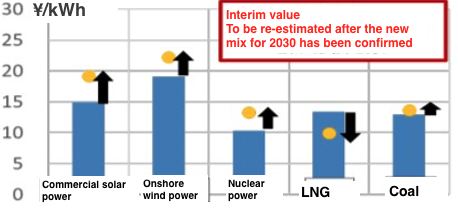Abandoned plans for Suzu and Maki Nuclear Power Plants: the beginning of the end? Nuke Info Tokyo No. 98
 |
|
The joy of the citizens of Suzu on hearing that the
Suzu Nuclear Power Plant plan had been cancelled |
On Dec. 24th, 2003, Tohoku Electric Power Company officially announced that it was abandoning its plan to build the Maki Nuclear Power Plant in Maki Town, Niigata Prefecture. According to the company the proposal for the construction dates back 32 years, but if one counts from the time when, in order to disguise its plan to build a nuclear power plant, the company bought land under the pretense of building a health resort, the project is actually 40 years old. However, in the end the resolute resistance of the local people against the nuclear power plant prevailed.
This is the first time that a construction plan has been abandoned for a nuclear power station which was included in the government’s Basic Plan for Electric Power Development and which had already commenced the safety screening process. In the same month, on December 5th, the Suzu Nuclear Power Plant plan (Suzu City, Ishikawa Prefecture), which has been pursued jointly by Kansai, Chubu and Hokuriku Electric Power Companies, was declared ‘frozen’ by the three companies involved. In reality this means that the project has been abandoned. This is the first time that any electric power company has abandoned plans on the basis of its own management decision.
That’s two ‘firsts’ in a row. What these cases have in common is that the resistance of the local people for around thirty years prevented the companies from constructing the plants, until times and circumstances combined to encourage them to abandon their plans. In the end, their long struggles bore fruit. It is just as Yohsaku Fuji, President and Director of Kansai Electric Power Company (KEPCO), said regarding the Suzu Power Plant plan: ‘The resistance movement was very strong. Time was moving on, but we hadn’t even begun a location assessment. During that time energy demand has become sluggish. Price competition has become fiercer as a result of liberalization. The circumstances have changed completely.’ The same fate befell the construction plan for the Maki Power Plant, which was abandoned with the safety screening process still on hold.
The same ‘first time’ situation is about to visit the construction plans for other nuclear power plants that have been blocked in the same way. This is the beginning of the end for them too. The Mayor of Mihama Town (Fukui Prefecture) announced on December 9th the postponement of a decision regarding a petition presented to the Town Council in the Fall of 2001 requesting the extension of the Mihama Power Plant. As reasons, the Mayor cited the circumstances facing KEPCO, namely the downward correction for electricity demand estimates and cost competition following the liberalization of the electricity market.
Continuous opposition stopped construction of nuclear power stations
The revocation of the plans for the Maki Power Plant is a direct result of a decision on December 18 by the Supreme Court to reject a lawsuit by the proponents of nuclear power. As a result of this decision, Tohoku Electric was unable to procure the land adjacent to the land where the core of Reactor Unit 1 was to be built. Tohoku Electric claims to be utterly dissatisfied with this ‘disturbing decision’. However the Denki Shimbun newspaper, which reported about the court decision in its December 22nd issue, anticipating the official decision of Tohoku Electric wrote, ‘Unlike the era of constant progress, during this era of liberalization withdrawal is one possible strategy’. The decision of the Supreme Court was a good excuse for withdrawal.
The land which Tohoku Electric tried unsuccessfully to buy originally belonged to the town, but the Mayor sold it to members of an anti-nuclear group. His action was prompted by Japan’s first ever local referendum regarding the location of a nuclear power plant, conducted on August 4th, 1996. The turnout reached 88% and 61% of the valid vote cast (54% of all eligible voters) opposed the nuclear power plant.
In spite of the criticism from the proponents of nuclear power that the Mayor sold the land without the approval of the Town Council, the Mayor was re-elected and the Niigata District Court, the Tokyo High Court and also the Supreme Court all upheld that ‘this measure, taken in order to abide by the result of the referendum, was in accordance with law’. It could be said that, in effect, the Supreme Court itself concluded that the volition of the people, as expressed in the public referendum, had to be respected.
The thing which made the referendum possible in the first place was another piece of land – not in this case land owned by the local government, but land collectively owned by opponents to the nuclear plant. This piece of land was located on the coast on the proposed site of Reactor no.3. This became a lever for the opposition movement, because it halted the safety screening process.
When the former Mayor, a proponent of nuclear power, was about to sell the land in question to Tohoku Electric, the women of the town organized a hunger strike in the entrance hall of the Town Hall and workers organized a sit-in in front of the Assembly Hall, so that the council meeting had to be cancelled. If just one element in this 30-year plus struggle had been missing, instead of the plan being abandoned, the nuclear power station might be operating today
Take the next step confidently
The collapse of the plans for the Suzu and Maki power plants teaches us again the importance of keeping the campaign going and never giving up. Of course, the nuclear power problem is far from over. Nation-wide there are more than 50 reactors in operation and the government is determined to implement its nuclear fuel cycle policy no matter what. Nevertheless, this experience clearly shows that phasing out nuclear power is not ‘an unrealistic dream’.
The detection of the ‘trouble concealment’ at Tokyo Electric Power Company (TEPCO) led to the suspension of the operation of one nuclear reactor after the other. In the wake of this scandal the problem of the insecurity of nuclear power as a source of energy supply was raised again last summer. Moreover the blackout in North America showed that a high dependency on nuclear power prolongs blackouts.
In an article in the December 8th issue of Denki Shimbun, which refers to the ‘freezing’ of the construction plan for the Suzu Power Plant, a staff member of the Agency of Natural Resources and Energy is quoted as saying, ‘The notion that the construction of power plants is connected to stable energy supply has changed’. And the Secretary to the Minister of Economy, Trade and Industry made the following comment: ‘There is a shift from increasing the supply and supplementing the quantity to lifting the quality of demand and supply.’
Evidently the times and circumstances have changed. Let’s take the next step confidently.
(By Baku Nishio)
Suzu and Maki Nuclear Power Plant Datelines
| Year | Maki | Suzu | Other |
| 1965 | Purchase of land for health resort begins | Japan’s first commercial reactor (TEPCO GCR) goes critical | |
| 1969 | Newspaper article reveals nuclear power plant plan | ||
| 1971 | Tohoku Electric officially applies to Maki Town | Power companies start maneuvering | |
| 1975 | Local government requests central government for site consideration | First national anti-nuclear energy gathering held in Kyoto | |
| 1976 | Kansai, Chubu and Tohoku Electric Power Cos announce joint site proposal | ||
| 1979 | Three Mile Island accident | ||
| 1981 | Included in the government’s Basic Plan for Electric Power Development | ||
| 1982 | Tohoku Electric applies to government for permission to construct reactor | ||
| 1983 | Opponents unable to acquire land. Tohoku Electric applies for suspension of safety screening, advising government of changed siting plan. | ||
| 1986 | Chernobyl accident | ||
| 1989 | Citizens stage 3 week action to block City Hall in response to site inspection by KEPCO. Inspection stopped. | ||
| 1991 | Growth in electricity demand begins to slow down | ||
| 1995 | Attempts to sell town land to Tohoko Electric blocked by opposition campaign. Regulation for citizens’ referendum passed. | Liberalization of wholesale electricity begins. Monju accident. | |
| 1996 | Representative of Citizens’ Referendum Action Committee elected Mayor. Referendum held. Nuclear power plant rejected. | ||
| 1999 | Mayor sells town land to members of Citizens’ Referendum Action Committee. | JCO criticality accident | |
| 2000 | Governor of Mie Prefecture cancels Ashihama Nuclear Power Plant plan. Liberalization of electricity sales to large scale consumers. | ||
| 2001 | Overwhelming rejection of nuclear power plant in citizens’ referendum in Miyama Town, Mie Prefecture | ||
| 2003 | Nuclear power plant plan abandoned | Nuclear power plant plan abandoned |

